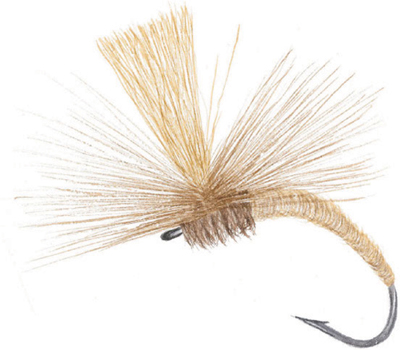
The Original Recipe
The creation of the Klinkhåmer Special by Dutchman Hans van Klinken is an object lesson in identifying a problem, gathering information and coming up with a solution. This highly effective half-wet, half-dry emerging caddis pattern created a new class of flies and led to the development of a range of hooks specifically designed for it.
Hans took up fly-fishing in 1971 at the age of 15, and was very soon undertaking solo journeys to fish the wilder parts of Norway, Sweden and Finland. He began fly tying in 1976 and focused particularly on parachute and emerger patterns, as well as realistic nymphs. While fishing for grayling fishing large patterns well sunk in the surface layer, as a friend had advised. He had been soaking dry flies to achieve this, and they had been working well, but Hans wanted to come up with something new. The inspiration came from a large and strongly curved caddis larva that he found in the stomach of a grayling, and in order to imitate this on the surface Hans tied a slim body of light tan dubbing right down to the bend on a large grub hook and gave his creation an upright poly yarn wing—offering excellent visibility—and a heavy duty parachute hackle.
In his own words, “On the 27th of June 1984, my first Klinkhåmer Special landed in the surface film of Norway’s mighty Glomma River.” The new fly floated well even in fast-moving broken water, with the majority of the hook hanging deep and almost perpendicular through the surface layer, and to Hans’s astonishment the fish took the fly aggressively. He landed three grayling in short order and then set about fine tuning his new pattern.
Naming it the L.T. (Light Tan) Caddis, Hans gave the fly as slim an abdomen as possible using poly dubbing and added a peacock herl thorax. The standard hackle for the original pattern is a large blue dun. The fly changed its identity a few years later when Hans wrote an article for a Dutch fly-fishing magazine and the legendary flytier Hans de Groot, who was on the editorial staff, renamed it in Hans’s honor and gave it a Scandinavian flavor. The diacritical mark over the “a” in Klinkhåmer has now largely been dropped.
Hans van Klinken, who lives in the Netherlands, has been tying flies since his early 20s, and has given fly tying lectures, classes and workshops across Europe, Asia and North America, as well as contributing to many books on the subject.
Hans soon found that the pattern worked especially well for large grayling, which tend to push high-floating dry flies aside when they go to take them. He believes this is a result of the grayling’s protruding lower lip, which is designed primarily for bottom feeding, but the fish take the “deep surface hanging emerger” much more easily and the pattern produces a far higher proportion of hook-ups.
Hans had success with his fly throughout Europe, for both grayling and trout, and then took Atlantic salmon on larger versions in Newfoundland. The fly has since become popular around the world from Australia and New Zealand to Russia and North America.
Seen from below, the Klinkhåmer presents a distinctive footprint on the water and an enticing profile.
HOOKS AND VARIATIONS
Although the large grub hook suited the pattern, Hans worked with manufacturers to develop the perfect hook with the right bend and a wide gape. Several such hooks are now available, some with a steady long curve, and others with an extreme bend partway back from the eye so that the hackle and thorax lie flat on the water while the abdomen curves dramatically downward.
Klinkhåmers today tend to be tied in smaller sizes than the originals, and in a huge range of colors to match a variety not only of different caddis but also upwinged emergers as well as terrestrials. Further variations on the theme include dubbing for the thorax, a turkey biot segmented abdomen, a foam wing post and a CDC soft hackle for smaller patterns. It’s the shape that counts!
Sharing the Praise
Hans van Klinken graciously refuses to take all the credit for the Klinkhåmer pattern because several flytier came up with very similar ideas independently. Among these are the American Mike Monroe, who wrote about his “Paratilt” in 1979, Tomas Olsen of Sweden, who developed a wingless deep hanging emerger in 1983 and another American, Roy Richardson, who produced a fly similar to the Klinkhåmer in 1986.